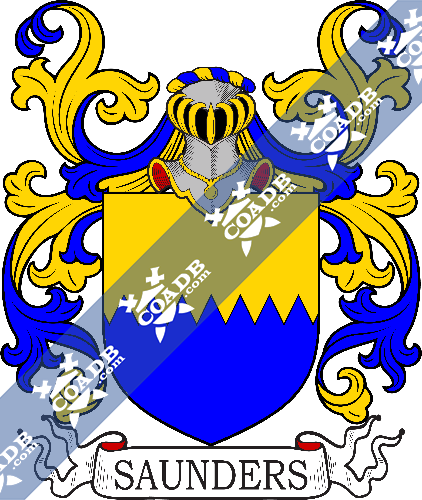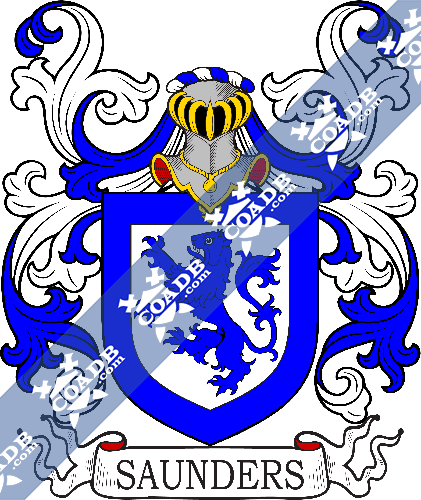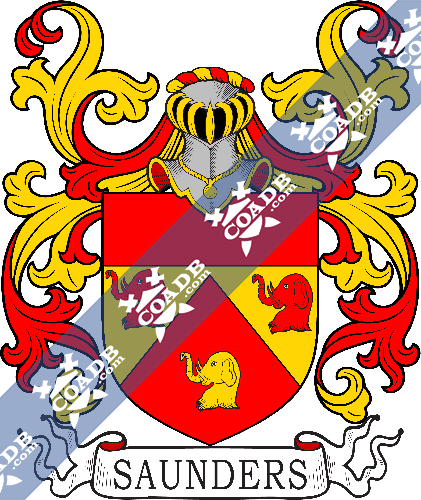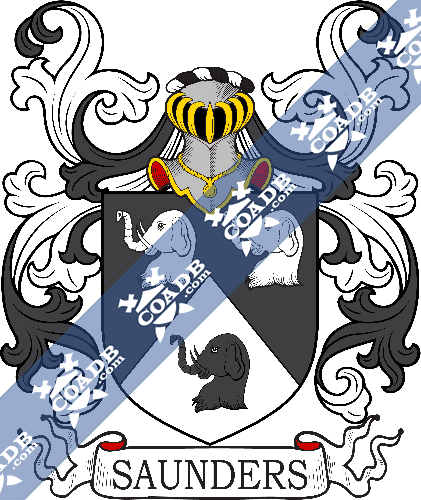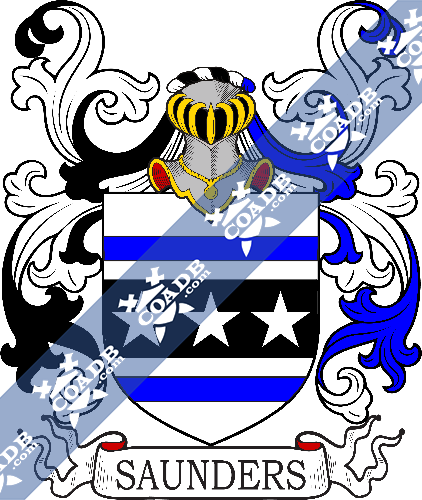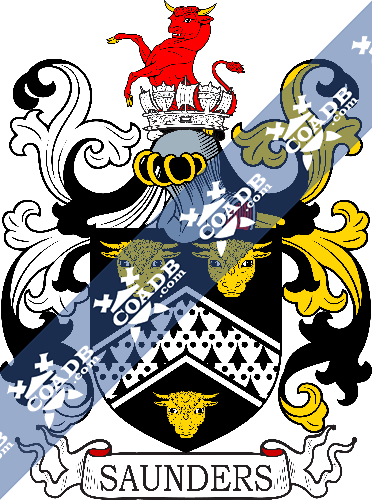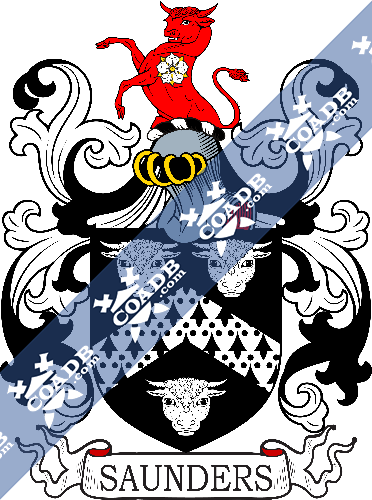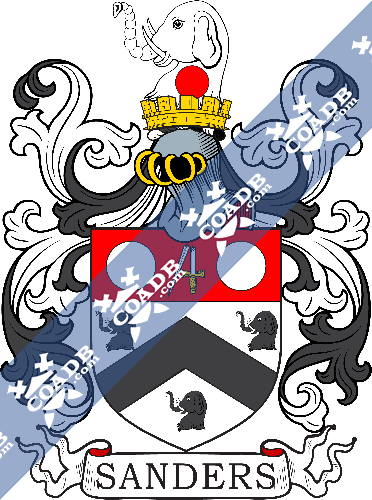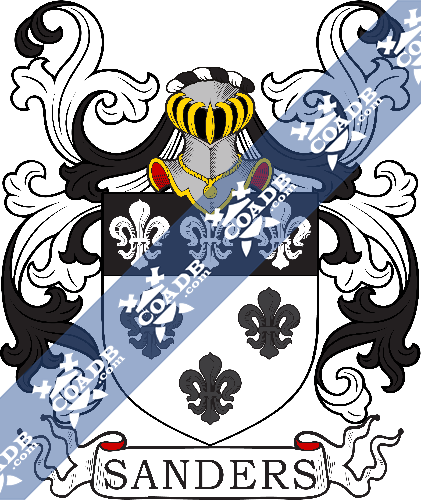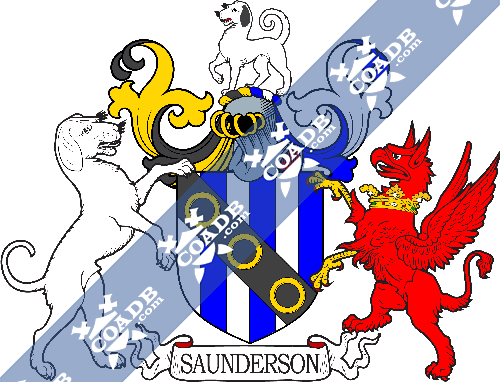Saunders Family Crest, Coat of Arms and Name History
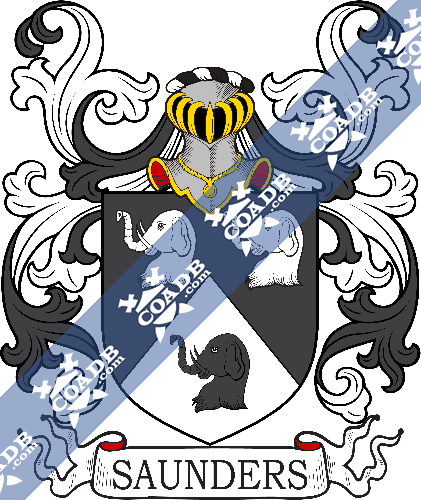
Saunders Coat of Arms Gallery
Don’t know which Coat of Arms is yours?
We can do a genealogical research. Find out the exact history of your family!
Learn MoreSurname Name Meaning, Origin, and Etymology
This is an English and Scottish baptismal last name meaning “the son of Alexander”, with Saunder (or Sander) being a medieval nickname for the ancient male personal (first) given name Alexander. The first bearers in England came of a town/village called Sanderstead in county Surrey, which was documented in 871 AD in the Anglo-Saxon Chronicles (spelled a Sondenstede, meaning the house on sandy lands). The given named Alexander (or Alexandros) is an ancient Greek name meaning “Defender of the people” or “Protector of men”, likely given to someone who portrayed prowess in battle and was able to withstand or push back an enemy line. The name was popularized in Indo-European culture by Alexander the Great (356-323 BC) who was King of Greece and Macedonian and member of the Argead dynasty, considered one of the most successful military commanders in history, and conqueror of vast lands (ex. modern day Turkey, Lebanon, Egypt, Pakistan, Iraq, Iran, Afghanistan, etc.). The family was first found in Wicklow, Ireland, where they received a grant of lands by Gilbert Fitz Gilbert de Clare, more commonly known as Strongbrow, Earl of Pembroke, for their help during his invasion of Ireland in 1172 AD.
Mark Antony Lower, in his book Patronymica Britannica, states: “The family of this name in county Wicklow, pretend that their ancestor came into England about the year 1270 AD, and that he sprang from Robert, Lord of lunspruck, who was second brother, of Rodolph, Count of Hapsburgh, and subsequently Emperor”.
Reg Willis, in his book Saunders: Your Family Origin states the following in regard to the history of the Saunders family name and its genealogy: “The ancient lords of Insbruck, in the Austrian Tyrol, are claimed as the ancestors of this family. Sir Harloven Saunders, who came to England about 1370, traced his descent from Robert, Lord Insbruck, brother of Rodolph, County of Hapsburgh and later Emperor of the Holy Roman Empire (1273-1291). The family, whose name has been variously spelled as SAUNDERS, SAUNDER and SAUNDRES, held lands in the shires of Northampton and Buckingham until the reign of Charles II (1660-1685). About this time, the family removed to Ireland, acquiring lands in the County of Wicklow. The family later obtained properties in Kildare, Meath and Dublin. In Ireland, members of the family were active in local government, several of them holding the postion of magistrate for the County of Wicklow”.
However, through using Wikitree.com (see below), I have traced the name back to Kings of France and to a man named Chortdoberus Neustria, who lived in 600 AD. This should be taken with a grain of salt as I cannot verify the accuracy of the research.
Spelling Variations
Common spelling variants or names with similar etymologies include Saunderson, Saunder, Sanders, Saundre, Saundres, Sawndir, Sawdirson, Sandys.
Popularity & Geographic Distribution
The last name Saunders ranks 439th in popularity in terms in the United Status as of the 2000 Census. The name ranks particularly high in the following seven states: Virginia, Delaware, Maryland, Connecticut, and West Virginia.
The surname Saunders frequency/commonness ranks as follows in the British Isles: England (121st), Scotland (353rd), Wales (90th), Ireland (857th) and Northern Ireland (823rd). In England, it ranks highest in Buckinghamshire and Hertfordshire. In Scotland, it ranks highest in Kinross-shire. In Wales, it ranks highest in Brecknockshire. In Ireland, it ranks highest in Kilkenny.
The name is also present throughout the remainder English speaking world: Canada (254th), New Zealand (144th), Australia (142nd), and South Africa (388th).
The 1890 book Homes of Family Names by H.B. Guppy, states the following in regard to this surname: “The two varieties of this name are confined south of a line drawn from the Humber to the Dee, being
well scattered over the part of England thus defined. The name is best represented in Devon, and after that in Dorset, Bucks, and Cambridgeshire. In the north of England its place is taken by Sanderson, which is most numerous in the counties of Durham and Northumberland”.
Early Bearers of the Surname
One early bearer of this surname was Henry Sandres who was documented in the Subsidy Rolls of Worcestershire in 1275 AD. The Hundred Rolls of 1273 AD, a census of Wales and England, known in Latin as Rotuli Hundredorum lists two bearers of this surname: Richard frater Sander in county Salop and Thomas filius (son of) Saundre of county Northampton. Kirby’s Quest documents one William Saundres in county Somerset during the reign of King Edward III of England (1327-1377). The Poll Tax of Yorkshire in 1379 AD lists five bearers of this last name: Cristiana Sawndir, Ricardus Sawndirson, Matilda Saunder-wyf, Johannes Saundirman, and Johannes Saundirson.
Earliest Known Ancestor of the Saunders Family
The earliest known ancestor of the Saunders family was Charibert von Neustria, known as “Chartibertus Nobilis” who was born at in an unknown location, although likely what became France, around 590 AD. The direct male pedigree from him goes as follows:
Chortdoberus Neustria (around 600 AD in Neustria)
Lambert I “Count of Neustria” de Bourgogne (around 620 AD in Poiters, Vienne, France)
Robert II Chordobertus Robertian (around 655 AD in Istria, France)
Lambert II Robertian (670 AD in Palatine)
Robert Hesbaye or Rupert I, Comte de Hesbaie (around 700 AD in Wormsgau, Saxony, Germany)
Thuringbert or Turincbertus (757 AD in Worms, Germany)
Robert (Rutpert II), Count of Worms, Duke of Hesbaye (around 770, Wormsgau)
Rutpert or Robert III, formerly Robertian aka Hesbaye (around 789 AD in Worms, Germany)
Robert IV de Neustria (around 820 France)
Robert I de France, formerly Robertian (886 Angers, France)
Hugues le Grandm Comte de Paris, marquis de Neustrie (898 AD in Paris)
Hughues or Huigh Capet, King of the Franks (around 941 AD in Paris)
Robert Cape or Robert II, the Pious King of France (around 972 AD, Orleans, France)
Robert I le Vieux Capet (around 1011, Meulan, France)
Henri de Bourgogne (around 1034, Bourgogne, France)
Eudes I, Duk de Bourgogne (around 1058 AD in Dijon, France)
Hughues II de Bourdgogne (around 1085 in Dijon, France)
Eudes II “Odo” (around 1118 AD in Bourgogne, France)
Hugues III, Duc de Bourgogne (1148 AD in Burgundy, France)
Alexandre I de Bourgogne (around 1168 AD in France)
Eudes de Montaigu (1196 AD in Montaigu)
Guillaume I de Bourgogne or Montagu (born 1222 AD)
Alexander de Montagu, Seigneur de Bussy (1250 in Limousin, France)
John Alexander Saunders (1250 AD in England)
John Alexander Saunders married a woman named Margaret and had three sons with her: Thomas I, Robert Alexander, and Thomas Alexander. His son Thomas I was born in Reigate, Surrey, England in 1320 AD and he had a son named Thomas II born in Charlewood in 1388 AD. He in turn had a son named Richard. This Richard Saunders was born in Norhamptonshire in England in 1405 and he married a woman named Aricola with whom he had a son named John. Lord John was born in Rothwell, Northamptonshire in 1430 AD and he married Joan Lambert, with whom he had four issue: Edward, John, Robert, and Edith (Holbrook). Edward Saunders was born in the same city in 1455 and he had two sons: Thomas and William. His son Thomas was born in 1489 and he married Margaret Cave and had three sons with her: Christian, Lawrence, and Ambrose.
History, Genealogy, and Ancestry
The famous genealogist Bernard Burke’s book “The Landed Gentry” discusses three branches of this family: 1) Saunders of Wennington Hall, 2) Saunders of Largay, and Saunders of Saunders Grove.
Saunders of Wennington Hall
William Allen Francis, Esquire of Wennington Hall in county Lancaster and Black Torrington in county Devon was born in 1818. He was Justice of the Peacy, Deputy Lieutenant, and High Sheriff in 1862. In 1841, he married Dorothy, daughter of Josias Morley of Beamsley Hall, and had seven issue with her: Francis Morley, Charles Morely (Captain 1st Royal Lancashire Militia and Justice of the Peace), Clervaux Morley (of Bovacott, Justice of the Peace for Devon, married Eleanor Frances Unwin), George Morley (Lieutenant 106th Light Infantry), Eleanor Jane (married Reverend Charles Stead Hope of Holy Trinity Vicarage), Frances Debonnaire, and Adeline Clecre. Burke traces the Saunders genealogy or lineage back to a family that, who with the Morleys lived on the Manor of Wennington. Before the era of King Edward II of England, the manor was owned by William de Wennington, which passed to the Morleys around 1330 AD. It was purchased by the Marsdens in 1673, and then it was purchased by Richard Saunders. Rich was an Esquire of Fair Lawn in county Lancaster who was born in 1764, the eldest son of William Saunders and Elizabeth Rudd. In 1808, he married Anna Maria, daughter of John Leaper-Newton of Mickleover, and he had two children with her: William Allen Francis (mentioned at the beginning of this paragraph) and Anna Maria Alice (married Reverend Charles Hesketh, Rector of North Meols). The Saunders Coat of Arms was blazoned in heraldry as follows: Per chevron argent and sable three elephants’ heads erased counterchanged, with the crest being an elephant’s head erased argent.
Saunders of Largay
Richard Saunders, Esquire of Largay in county Cavan, Ireland was born in 1800. In 1821, he married the niece of Sir John Day, Advocate-General of Bengal, and had the following children with her: Augustus Richard (Lieutenant 60th Rifles), Henry, Edward (married Caroline Knollys), Susan (married John Richards of Barnagh, Mayo), Julienne (married A.Z. Cox of Herne Gate and Harwood Hall), and Mary Anne (married Reverend Mainwairing White). Burke traces the ancestry of Saunders genealogy back to Robert Saunders, a Colonel in Oliver Cromwell’s Army during the Revolution, who was also the Govenor of Kinsale in county Cork. He received thousands of acres in a land grant of “The Deeps” in county Wexford from King Charles II. He married Sarah, daughter of Henry Owen FitzHerbert of Stafford, and had eleven children with her: Elizabeth (married John Puckle of New Ross), Mehetabel, Rebecca, Hannah, Bethia, Mary, Bathsheba, Jane, Joseph (of Saunders Court, married Jane Whitfield), Robert (of Dublin, Prime Serjeant at Law), and Anderson (whose descendants carried on the male line). Anderson Saunders married Elizabeth Battersby and had a son named Anderson. This Anderson was an Esquire of Newtwon Saunders and was born in 1716. He first married Lucy, daughter of Owen Wynne of Haslewood and had issue with her: Richard and Joanna (married Thomas Townley Dawson of Kinsealy). He later married Elizabeth Wallbanke Childers of Cantely Lodge and also had issue with her: Anderson, William, and Elizabeth. He was succeeded by his son Richard who married Anne Parker and had eight children with her: Owen, John Robert, Anderson, Richard, Belinda, Anne Mary, Ellen, and Jane. He was succeeded by his eldest son Owen of Largay, who in 1799, married Mary Anne, daughter of Richard Sadleir of county Tipperary, and had children with her: Richard, Henry Owen (of Greyfort, married Ellen Moore), Ellen (married Thomas Sadleir), and Jemima (married Edward Synge). Owen died in 1831 and was succeeded by his eldest son: Richard Saunders, who was an Esquire of Largay and representative of the family in Ireland. The Saunders Family Crest has the following heraldic blazon: Argent, a chevron between three elephants’ heads erased sable on a chief gules between two plates a sword in plane, the blade broken, point hanging down all proper, with a crest that is out of a mural crown proper an elephant’s head argent charged with a torteau.
Saunders of Saunders Grove
Robert Joseph Pratt Saunders was Esquire of Saunders Grove in county Wicklow who was born in 1841 and succeeded his father in 1871. He was Justice of the Peace for Wicklow and Kildare, a Major in the Kildare Militia, a High Sheriff in 1878, and Lieutenant in the Royal Artillery. Burke traces the lineage of this family back to a branch of the Pendred family who lived in Northampton and later settled in Ireland during the reign of King William III. Through an heiress of the Saunders family, they acquired estates in counties Kildare and Wicklow and adopted the surname Saunders.
Early Americans Bearing the Saunders Family Crest
Matthew’s American Armoury and Blue Book mentions one blazon for Thomas Saunders who was born in Amsterdam, Holland: Sable, a chevron ermine between three bull’s heads carbossed argent. Crest: A demi-bull erased gules. He was the great grandson of Reverend Lawrence Saunders, the martyr, burned at Coventry in 1555.
Mottoes
We have identified four Saunders family mottoes:
Spes mea in Deo (My hope is in God)
Invidere sperno (I scorn to envy)
Nil conscire sibi (To have a conscience free from guilt)
Genitum se credere mundo (To believe oneself born for the world)
Grantees
We have 19 coats of arms for the Saunders surname depicted here. These 19 blazons are from Bernard Burke’s book The General Armory of England, Ireland, and Scotland, which was published in 1848. The bottom of this page contains the blazons, and in many instances contains some historical, geographical, and genealogical about where coat of arms was found and who bore it. People with this last name that bore a Saunders Coat of Arms include:
1) Sir Charles Saunders, Vice-Admiral, 1761
2) Saunders of Purley and Chaddleworth, Berkshire, 1766
3) Saunders, late Huck, Richard, M.D. (1777)
4) Saunders, Bigland, wife of, of county Gloucester, 1796
5) Saunders to Webb, James, John, and Frederick, of Kensington Gravel Pitts, county Middlesex, and Great Canford, county Dorset, 1797
6) Saunders, of Teale, county Devon, 1824
7) Saunders, late Richardson, of Manchester, county Lancashire, and Nunwick Hall, Great Salkeld, 1837
8) Saunders after Arundell, Frederick William, 1873
9) William Henry Saunders, Radcliffe, of Lullote, county Glamorgan, Wales, s. of John B, 1897
Notables
There are hundreds of notable people with the Saunders surname. This page will mention a handful. Famous people with this last name include: 1) Ab Saunders (1851-1883) who was an American cowboy and gunman from Mount Pleasant, Iowa known for his association with Billy the Kid and others, 2) Harold Henry Saunders (1930-2016) who was an ambassador that served at the United States Assistant Secretary of State for Intelligence and Research in the 1970s, 3) Rebecca Saunders (1967) who is an English composer from London who studied violin at the University of Edinburgh, 4) Reverend Turner Saunders (1782-1854) who was a Methodist preacher from Brunswick, Virginia, 5) Raymond Saunders (1934) who is an American artist from Pittsburgh, PA who is known for his paintings that have sociopolitical themes, 6) Michael Graham Saunders (1920-1975) was a neurophysiologist and researcher from London, England who is known for his development of Electroencephalography and his advocacy for computers in medicine, 7) Joseph W. Saunders (1945) who was the former CEO of Visa Inc., and 8) Arthur Frederick Saunders (1879-1947) who an English soldier from Ipswich who received the Victoria Cross who served in the First World War.
More information will be added to this section soon. If you would like to find out more about your lineage we offer affordable research services. We trace your lineage so you can learn more about your ancestors, where they came from, and who you are.
Blazons & Genealogy Notes
1) (co. Buckingham, Saperton, co. Lincoln, and co. Northampton). Per chev. sa. and ar. three elephants’ heads erased counterchanged.
2) (co. Northumberland). Per fess indented or and az.
3) (or Sanders) (co. Oxford). Ar. a lion ramp. az. on a border of the second a fleur-de-lis or.
4) (granted 1610). Per chev. or and gu. three elephants’ heads counterchanged, a chief second.
5) (Fun. Ent. Ulster’s Office, 1662, of the wife of Sir William Dixon, Knt.). Per chev. sa. and ar. three elephants’ heads erased, trunks elevated counterchanged.
6) (Fun. Ent. Ulster’s Office, 1597, Mrs. Ida Saunders, widow). Ar. on a fess sa. within two barrulets az. three mullets of the first.
7) (Wennington Hall, co. Lancaster). Per chev. ar. and sa. three elephants’ heads erased counterchanged. Crest—An elephant’s head erased ar. Motto—Spes mea in Deo.
8) (granted 3 May, 1761, to Sir Charles Saunders). Sa. a chev. erm. cotised ar. betw. three bulls’ heads cabossed or. Crest—Out of a naval coronet ar. a demi bull ramp. gu. armed and hoofed or.
9) (Pentre, co. Pembroke, originally from co. Surrey; settled in Wales since 18 Henry VIII.; the eventual heiress, Susan dau. and heir of Erasmus Saunders, m. David Davies, M.D., and was mother of Davies, of Pentre). (Glanrhwdw, co. Carmarthen; John E. Saunders, Esq., of Glanrhwdw, J.P. and D.L. of the co., was grandson of David Saunders, Esq., of Pentre). Sa. a chev. erm. betw. three bulls’ heads cabossed ar. Crest—A demi bull erased gu. on the shoulder a rose ar. maned gold. Motto—Invidere sperno
10) (Saunders Court, co. Wexford; descended from Joseph Saunders, Esq., of Saunders Court, eldest son of Col. Robert Saunders, who went to Ireland with Oliver Cromwell, was made by him Governor of Kinsale, and had a grant of 3,725 acres in co. Wexford, 1666. The heiress of this family, Jane, only dau. of Richard Saunders Esq., of Saunders Court, m. 1730, Arthur, first Earl of Arran, to whom she conveyed the estates). (Saunders Grove, co. Wicklow; descended from Robert Saunders, Esq., of Dublin, Prime Serjeant 1693, second son of Col. Robert Saunders, Governor of Kinsale, male line extinct. The heiress, Cordelia, dau. of Morley Saunders, of Saunders Grove, Prime Serjeant 1712, m. George Pendred, Esq., to whom she conveyed the estates). (Newtown Saunders, co. Wicklow, and Largay, co. Cavan; descended from ANDERSON Saunders, Esq., of Newtown Saunders, third son of Col. Robert Saunders Governor of Kinsale, whose direct male descendant and representative, Saunders, of Largay, is, by the termination of the two senior lines in heiresses, heir male of the family). Ar. a chev. betw. three elephants’ heads erased sa. on a chief gu. betw. two plates a sword in pale, the blade broken, point hanging down all ppr. Crest—Out of a mural crown ppr. an elephant’s head ar. charged with a torteau. Motto—Nil conscire sibi.
11) (Cheriton Fitz-Paine, co. Devon; exemplified to Frederick William Arundell, Esq., upon his assuming, by royal licence, 1873, the surname of Saunders). Ar. a lion ramp. az. betw. two flaunches of the last, each charged with an estoile of the first, a chief chequy of the second and erm. Crest—An eagle’s head ar. gorged with a collar chequy az. and erm. holding in the beak an estoile also az.
12) (Brickesworth, Sibbertoft, and Flower, co. Northampton). Per chev. sa. and ar. three elephants’ heads erased counterchanged. Crest—An elephant’s head erased per chev. counterchanged ar. and sa.
13) (South Weald, co. Essex). Ar. on a chev. betw. three elephants’ heads erased sa. as many plates. Crest—A dexter arm embowed in armour holding in the gauntlet a sword all ppr.
14) (Harnington and Welford, co. Northants; Francis Saunders, son and heir of William Saunders, Esq., of Welford, and grandson of Edward Saunders, Esq., of Harnington. Visit. London, 1568). Per chev. sa. and ar. three elephants’ heads erased counterchanged, tusked or. Crest—An elephant’s head erased sa. eared and tusked ar.
15) (London; George Saunders, citizen and haberdasher, second son of William Saunders, Esq., of Welford, co. Northants. Visit. London, 1568). Same Arms and Crest, a crescent for diff.
16) (Long Marston, co. Herts). Same Arms. Crest—An elephant’s head erased sa.
17) (Down House, Ealing, co. Hants). Sa. a chev. erm. betw. three bulls’ heads cabossed ar. Crest—A demi bull gu.
18) (cos. Leicester, Oxford, and Warwick). Per chev. sa. and ar. three elephants’ heads erased counterchanged. Crest—An elephant’s head erased sa. cared ar. (another, erased per chev. ar. and sa.).
19) (London). Ar. a chev. betw. three elephants’ heads erased sa. on a chief gu. a broken sword ppr. hilt and pommel or, the point hanging down betw. two plates. Crest—Out of a mural coronet ppr. an elephant’s head ar. eared sa. charged on the breast with a pellet.

